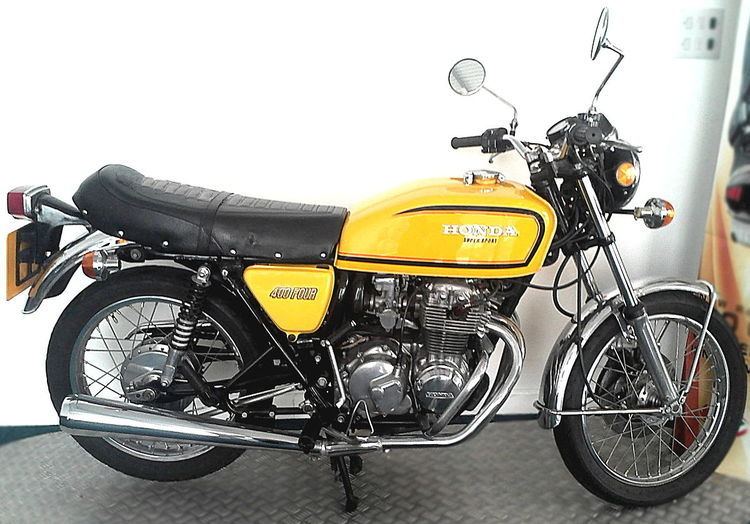Production 1975–1977 Successor CB400T | Also called 400 Four Predecessor CB350F Class Standard | |
 | ||
The Honda CB400F is a motorcycle produced by Honda from 1975 to 1977. It first appeared at the 1974 Cologne motorcycle show, Intermot, and was dropped from the Honda range in 1978. It had an air-cooled, transverse mounted 408 cc (24.9 cu in) inline four cylinder engine with two valves per cylinder operated by a single chain driven over head camshaft. Fuelling was provided by four 20 mm Keihin carburettors. The CB400F is commonly known as the Honda 400 Four.
Contents
Background
After introducing the four-cylinder CB750 motorcycle in 1969, Honda followed with a string of smaller capacity four cylinder models; the CB500 Four in 1971 and the CB350 Four in 1972. The CB350F was available for two years until Honda announced the CB400F model.
For the most part, the CB400F was simply an upgraded version of the 350 model from the previous year. At the time Honda's R&D department had devoted much of its resources towards automobile models such as the Civic. This meant that motorbike development was limited to mechanical changes. In order to develop the CB350F into the CB400F, Honda increased the bore and modified the cylinder head to raise the compression ratio. In a first for Honda, a sixth ratio was fitted to the gearbox. Instead of aping the styling of the bigger Universal Japanese Motorcycle style CB750, like the 350F had, the CB400F had a more café racer look with lower handle bars, rear set footpegs and more svelte styling. It also gained one its most recognisable attributes, a swooping four-into-one exhaust system.
Although aimed at the sporting segment of the market, the four-stroke CB400F did not have the acceleration of the competition's two-strokes, particularly the triples from Kawasaki. But what the CB400F engine lacked in power it made up for in refinement, the small-displacement four-stroke being smoother, quieter and much more economical than the two-strokes.
Reception
The CB400F was widely well received by the motoring press and reviewers. They praised its renewed focus over the previous 350F model, preferring its clean lines and sporty café racer looks. In America however the CB400F was not the sales success Honda had anticipated. Honda revised the model in the US in an attempt to recapture lost sales by fitting higher bars and footpegs set further forward, but the CB400F struggled against the dominant Kawasaki twin cylinder model. It was also 15% to 20% more expensive than its competition.
Variants
The CB400F was produced in three variants during its production cycle; the F, F1 and F2.
To comply with licence restrictions in France and Japan Honda also produced a 398 cc (24.3 cu in) version by fitting a shorter 48.8 mm (1.92 in) stroke crankshaft.
Performance
The CB400F produced a claimed 37 bhp (28 kW) at 8,500 rpm and 24 lb·ft (33 N·m) at 7,500 rpm. Bike magazine reported a 0 to 1⁄4 mile (0 to 400 m) time of 14.68 seconds. During the same road test they recorded a top speed of 103.80 mph (167.05 km/h) prone and 93.5 mph (150.5 km/h) sitting up.
Racing
The CB400F was a very successful motorcycle in club or privateer racing. Kaz Yoshima, a former employee at Honda's R&D department in Japan, built 492 cc (30.0 cu in) race versions capable of 13,500 rpm and producing an estimated 60 bhp (45 kW). Ron Haslam won the 1980 Formula 3 title on a CB400F prepared by Honda dealer Nettleton Motorcycles. He also came third in the F3 class at the Isle of Man TT on the same machine. Racing versions of the CB400F were also raced successfully in the Formula 2 under 500 cc four stroke/350 two-stroke class.
Legacy
Around 105,000 CB400F units were sold. The CB400F was succeeded by the lighter and more powerful twin cylinder Honda CB400T. It wasn't until 1989 that Honda introduced another 400 cc inline-four, the all new Honda CB-1. The 2006 PlayStation 2 title Tourist Trophy featured a CB400 Four as a prize for getting a gold 'Junior License'. In late 2011 a UK based company, David Silver Spares, announced they would be acquiring used CB400F's to restore and resell to the public. The aim was to use economies of scale to restore 49 CB400F bikes in batches. The project was featured by Classic Bike magazine in April 2012 and showcased the bike owned by Top Gear presenter James May.
